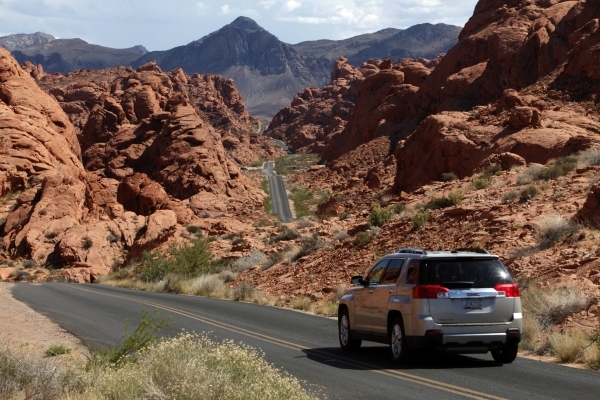Winter is wonderful time to visit scenic Valley of Fire
Valley of Fire State Park is a good destination during any season, but the cooler months are the most attractive time to visit this beautiful spot.
In summer, the desert heat is too intense for a prolonged stay. Spring and fall draw the most visitors, but winter is the quiet season when the park is least busy. Winter in the Valley of Fire is short, sometimes cold, but often balmy with the weak winter sun reflected and intensified by the sheltering sandstone walls.
Aptly named, Valley of Fire features vivid sandstone cliffs and eroded rock formations in fiery hues, from those of leaping flames and glowing embers to the bright white ash of spent fires. It is one of the oldest, largest and most popular of Nevada's 23 state parks, and many would say it is the most spectacular.
To reach this desert gem, drive north on Interstate 15 from Las Vegas about 55 miles to exit 75 onto state Route 169. The road cuts east 23 miles through the park. It heads toward a range of hills and then into a series of snaky turns before a steep decline into rugged arroyos. Soon the first of the bright sandstone outcroppings appear in stark contrast to the muted desert background. Desert vegetation stands out among the red sands, and the expanse of sky overhead seems brighter above the colorful cliffs.
Expect to pass through a park entrance where you pay a fee of $8 for Nevada residents or $10 for nonresidents. For frequent state park users, especially Nevada senior citizens, an annual pass will save you money. Passes may be purchased online at parks.nv.gov or at the Nevada State Parks Southern District office, 4747 Vegas Drive.
Start your adventures in Valley of Fire with a stop at the visitor center in the heart of the park. The center's film, exhibits and information desk provide an orientation to the park and its roads, trails and facilities. Visitors find out about the area's fascinating past, its plants and animals and its possibilities for outdoor activities. The bookshop offers a variety of books, maps and other information about the region, as well as souvenirs, toys, games and a few snacks.
Since those snacks are the only food available in the park, bring along a picnic lunch to eat in any of the scenic sites set aside for picnickers. Picnic tables, shade shelters and grills are available at Atlatl Rock, Seven Sisters, the Cabins, Mouse's Tank and White Domes.
The park has two campgrounds near Atlatl Rock, a popular site with an extensive display of ancient petroglyphs. Stairs take visitors close enough to view the rock art. The site was named for an implement used by ancient cultures to throw spears or darts when hunting. The campgrounds offer a total of 72 sites, available on a first-come basis for an overnight fee of $20 with a $10 surcharge for use of RV utilities hookups. An RV dump station is provided. Restrooms in the campgrounds include showers. Under clear conditions, overnighters experience the showy night skies that can be seen only beyond the glare of city lights.
Valley of Fire has a network of developed trails to help visitors explore points of interest among its labyrinth of cliffs and eroded canyons. Some are short walks to places such as the Beehives, the petrified remnants of ancient forests or Mouse's Tank, a natural catch basin named for a renegade of frontier times. Others are longer or otherwise more challenging, such as the 4½-mile Prospect Trail that includes a narrow slot canyon south of White Domes in the northern end of the park.
Because of traffic and safety concerns, biking and horseback riding are not allowed on most trails and roads in the park. The exception is the nearly seven-mile trail along the route of the Old Arrowhead Road in the southern part of the park.
The urge to climb among the sandstone rock ledges often gets unwary visitors into trouble. It is easy to scamper into danger when gradual slopes lead to precipitous overhangs and dangerous footing. Serious rock climbers with proper equipment, training and experience should check with rangers at the visitor center for approved climbing routes.
— Margo Bartlett Pesek's Trip of the Week column appears on Sundays.
























